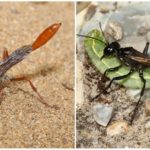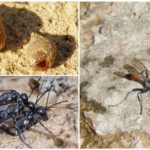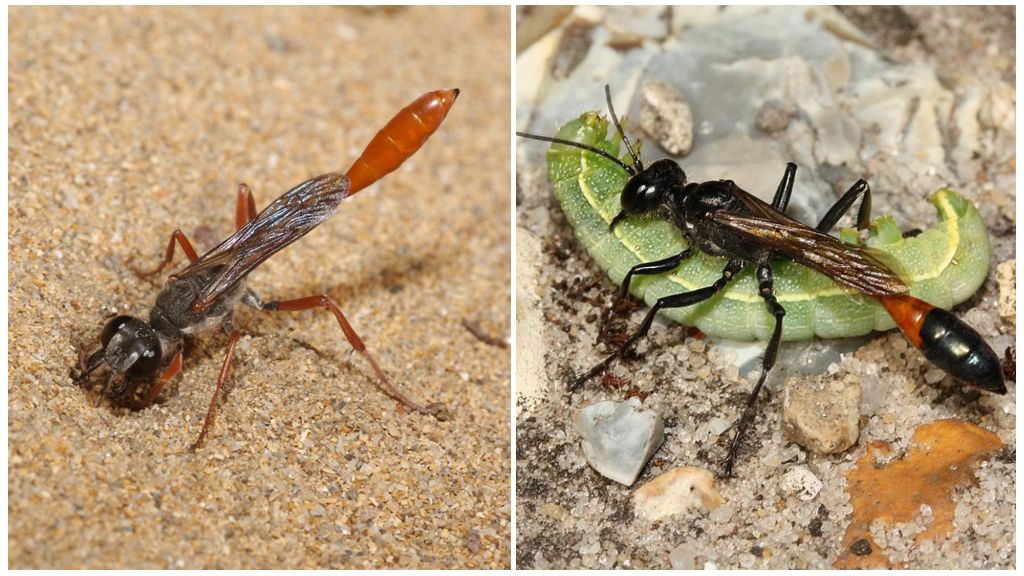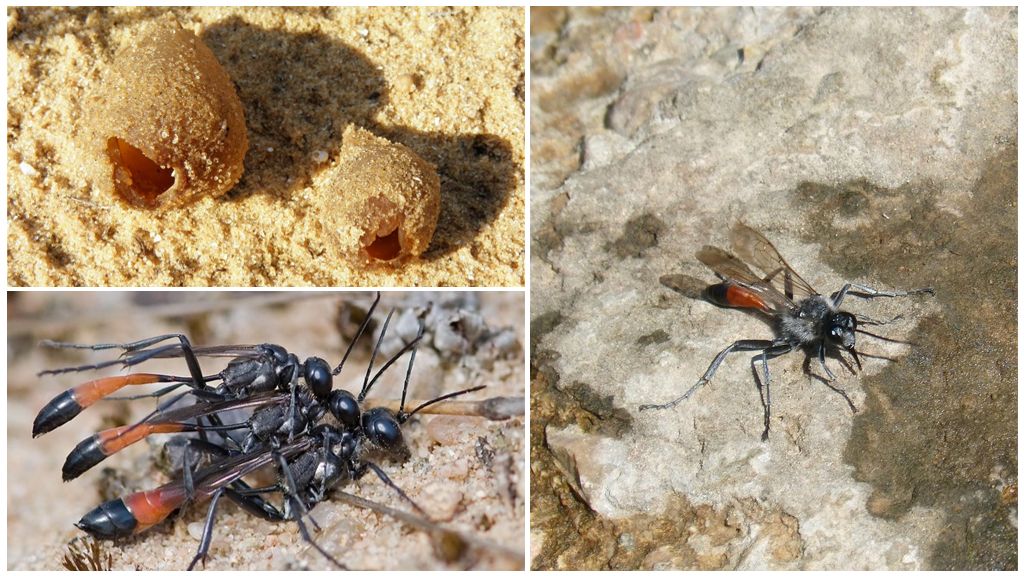Ammophile Digging Wasp
- Ammophile Digging Wasp
- Ammophile Digging Wasp
Digging wasp is a cumulative concept involving about 200 species. All of them are connected by a similar way of life, there are similarities in appearance. A prominent representative living in Russia is the ammophilus wasp. The name translated from Latin means love of sand. The largest representative of the genus is the rare wasp sphax, in many countries listed in the Red Book.
Appearance Description
Slender thin-bodied insects are not very similar in appearance to ordinary striped wasps. Mostly black color.The head is small, lowered to the bottom. Well visible jaws, straight long mustache. The chest is connected to the abdomen with a thin elongated segment. Belly itself flattened on the sides, bright red, orange.
On a note!
Long limbs end in a special scallop, which distinguishes the burrowing wasp from paper, public. Transparent thin wings are rarely used. Seeing the digging wasp ammophilus once, its appearance will be remembered forever. The photo is located below. The size of the female is from 25 to 38 mm, the males are somewhat smaller.
Lifestyle
Ammophile has been studied more and better than other relatives. Leads a single life, does not build tiered jacks, does not form a wasp society from working individuals. Each female is sexually mature, lives separately from the others. Insects do not communicate signs, do not send each other warnings. In behavior, the burrowing wasp ammophile is calmer, it reproduces offspring slowly, begins to lay eggs not in the beginning of spring, but in summer.
The mission of an adult is to find a potential victim in order to lay an egg in it. Each species chooses for itself a certain type of prey, ammophilia prey on larvae of the scoops.Finds them under the ground, paralyzes the nervous node, immobilizes. It pulls into the hole, which the female prepared for the larva in advance. She lays an egg on the body, closes the entrance, falls asleep with earth.
After 3-4 days the larva crawls out of the egg, which gradually begins to eat the prey. After 14 days, completes its development cycle, pupates. In this position winters. In the spring of the cocoon appears imago, creeps out. Mating occurs, after which the female begins to hunt for moths, laying eggs. Only one generation is developed per year.
On a note!
The burrowing wasp is widespread everywhere; about 10 species live in Russia. Occurs in forests, fields, gardens, gardens, summer cottages. Unique species - beewolf, Larar Amafens, ammophilus, spax.
Nutrition
The wasp ammophilia is a sandy - harmless and even useful creature. It feeds on the nectar of plants, juices of ripe fruit, vegetables, water. Sleeps among the grass, trees, clinging paws, jaws to a blade of grass, leaf, twig. Wakes up with the first sunshine.
On a note!
Hunting for scoop larvae brings substantial favor of manbecause the caterpillars are malicious pests of many crops. They eat up stocks even in barns.
Habitat
Adults fly where there is an abundance of food, as well as scoop larvae. The insect avoids clean free-flowing sand, as grains of sand quickly fill a newly dug mink. She must remain clean until the victim is thrown there.
The ammophilus wasp digger likes light soil suitable for digging. It contains impurities of clay, lime. The favorite places of insects are forest paths with sparse grass, sunny slopes, forest edges.
Minks digging wasps vertical, superficially resemble a well. Width is up to 2 cm, depth is about 5. At the bottom there is a single cell for the larva in the form of a small expansion. Pebbles, large lumps of the wasp are carried out, are laid near the nest. Insect loves to dig up a mink slowly. If you need to dig a few nests in advance, you will work all day.
Interesting!
The whole process of digging is simple, does not take much time. Jaws play the role of a shovel, paws - a rake. In conclusion, he finds a pebble to cover the entrance.After a successful hunt the next day will bring there a larva, exceeding it itself in size several times.
Is it dangerous for humans?
The digging wasps of our area are less poisonous than the usual striped insects. Wasp ammophila bites people extremely rarely, in case of urgent need. Prefers to quietly hide from human eyes. Sting uses as self-defense, if you accidentally press on it, step on, squeeze. Itself to attack, will not bite.
Burrowing wasp does not build nests in the form of cocoons, therefore there is nothing to protect. Even if a person comes to the place where the larva is hidden with the victim, it does not hurt because of its deep location.
On a note!
Ammophile does not transmit signs to other relatives, therefore there is no risk of attack of the whole swarm.
After bite standard arises allergic reaction, which can be eliminated by any alcohol tincture. Rarely develop severe allergies that require special treatment. If the digging insect has managed bite the child, the risk of an allergic reaction is somewhat increased due to a weak immune system. It is recommended to immediately give the baby an antihistamine drug in the form of drops, tablets - Claritin,Fenistil, Eltset, Diazolin. Treat the bite site with an antiallergic topical preparation.









